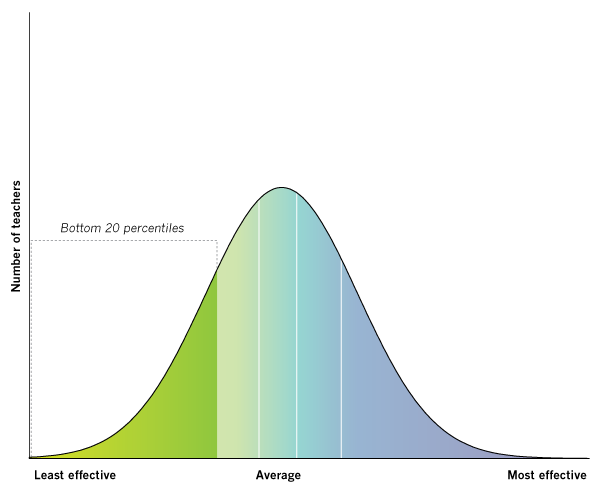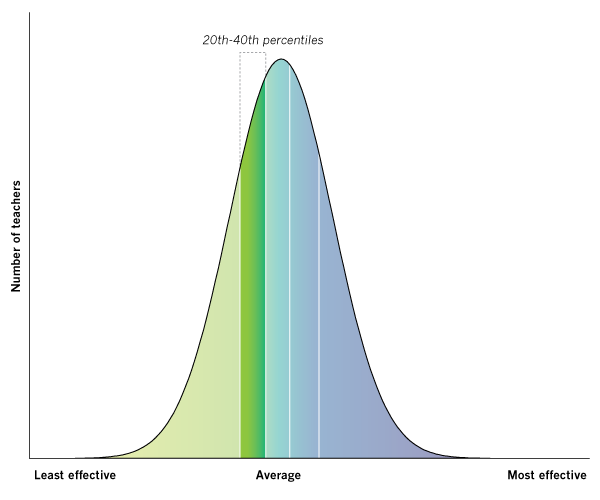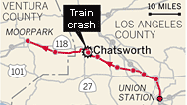Melody Anne Dennert
A 5th grade teacher at Dearborn Street Elementary in 2006
These graphs show a teacher's "value-added" rating based on his or her students' progress on the California Standards Tests in math and English. The Times’ analysis used all valid student scores available for this teacher from the 2002-03 through 2008-09 academic years. The value-added scores reflect a teacher's effectiveness at raising standardized test scores and, as such, capture only one aspect of a teacher's work.
Compared with other Los Angeles Unified teachers on the value-added measure of test score improvement, Dennert ranked:
- Least effective overall.
- Least effective in math. Students of teachers in this category, on average, lost about 10 percentile points on the California Standards Test compared with other students at their grade level.
- Less effective than average in English. Students of teachers in this category, on average, lost about 3 percentile points on the California Standards Test compared with other students at their grade level.
Dennert's LAUSD teaching history
2002-03 through 2008-09 academic years
- Dearborn Street Elementary, 2006 - 2004
Melody Dennert's Response:

While I do believe standardized tests can give valuable information about certain aspects of student progress, I do not believe that it tells the whole story. Student portfolios that show a progression of student work are much more valuable. While the Times indicates that standardized test scores should count for less than half of how a teacher’s effectiveness should be measured, that is not how the general public perceives these scores. It’s misleading not to include classroom-specific data along with these scores, such as whether the school departmentalizes subjects, how many students they typically have in a resource pull-out program, or how many students have an I.E.P. with testing accommodations. After reading other teacher responses, it seems many of the teachers with “Least Effective” status, including myself, didn’t even have all their students for the full day. My last year of teaching was also not included, even though I was there until late April 2007 before I left on maternity leave.
I taught at a School for Advanced Studies (SAS) in a non-SAS classroom. All four years I had the largest group of resource students in the fifth grade. For the first two years analyzed, I had an average of 8 students each year with I.E.Ps in resource pull-out for language arts, mathematics or both. These students were not in my classroom from 1 to 3 hours each day, receiving instruction for subjects reflected in my score. Many of these students had the testing accommodation of having the test read to them because of their learning disabilities. I typically had about the same number of English Language Learners from levels 2 through 5. Classes with this type of make-up require a lot of differentiated instruction where you have to look at the student’s specific needs and adapt your curriculum so that they can achieve grade level performance for all the content standards, including science and social studies.
While we did incorporate test-taking strategies into our curriculum, that was not our primary focus. For example, our grade level language arts goals focused on reading fluency and writing. Students can’t be successful in reading comprehension if they aren’t even reading at grade level. I wish my Open Court Scores were published as well, because they really showed how much progress my students made from September until June. We had an intense and comprehensive writing program where our students were producing grade level standards-based essays by the end of the year using Thinking Maps, including children who started fifth grade only being able to write a paragraph and use a simple web to brainstorm. Unfortunately my effectiveness for writing instruction cannot be measured on a Scantron. It wasn’t until my third year that we changed our language arts resource program so that the students stayed in my classroom full-time and I co-taught with the resource teacher. It’s very distressing that my fourth year wasn’t included because the co-teaching program was very successful. Furthermore, for all the years analyzed I was not the primary math instructor to the students pulled out of my class in the mathematics resource program and the Times notes that “Because there is more variation in math scores, very high or low performance in math counts for more.”
I was also the Science Lead Teacher and taught most or all (depending on the year) of the fifth grade classes science, including a review of fourth grade material before the science content exam. Our scores consistently rose and were above the state average. My teacher evaluations where an administrator observed my lessons were always meets or exceeds the standards. Ultimately, I believe teachers should have been given scores based on a comprehensive look at their teaching abilities across all the content standards. I totally agree that I can improve each year, as teaching is not a static profession; however, I do not believe my current score is an accurate reflection of my abilities as a teacher.
![]() The Times gave LAUSD elementary school teachers rated in this database the opportunity to preview their value-added evaluations and publicly respond. Some issues raised by teachers may be addressed in the FAQ. Teachers who have not commented may do so by contacting The Times.
The Times gave LAUSD elementary school teachers rated in this database the opportunity to preview their value-added evaluations and publicly respond. Some issues raised by teachers may be addressed in the FAQ. Teachers who have not commented may do so by contacting The Times.
|
|
 Delicious
Delicious
|
 Digg
Digg
|
 Facebook
Facebook
|
 Twitter
Twitter
|









